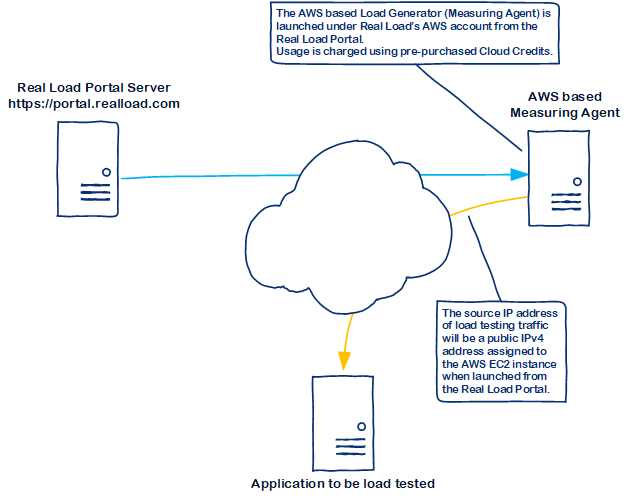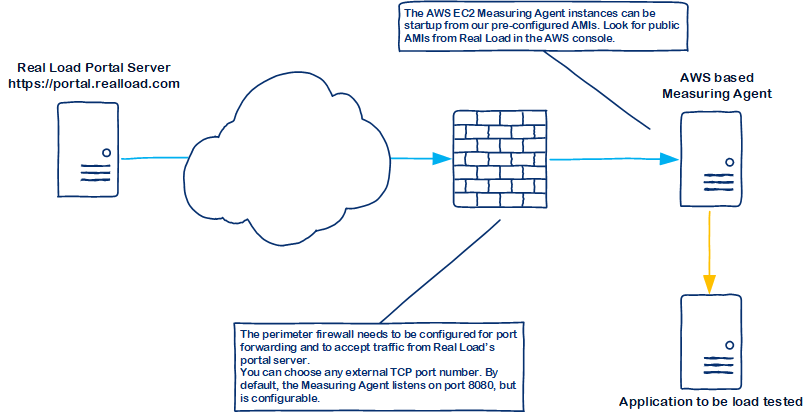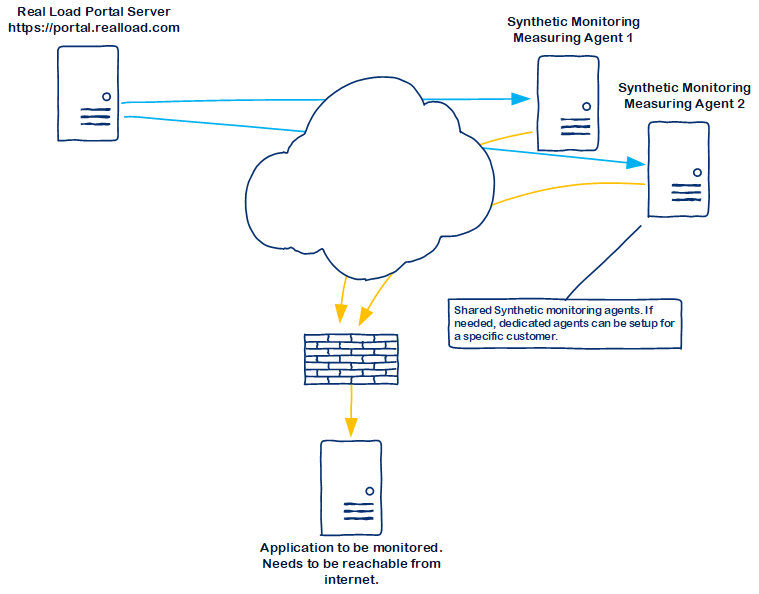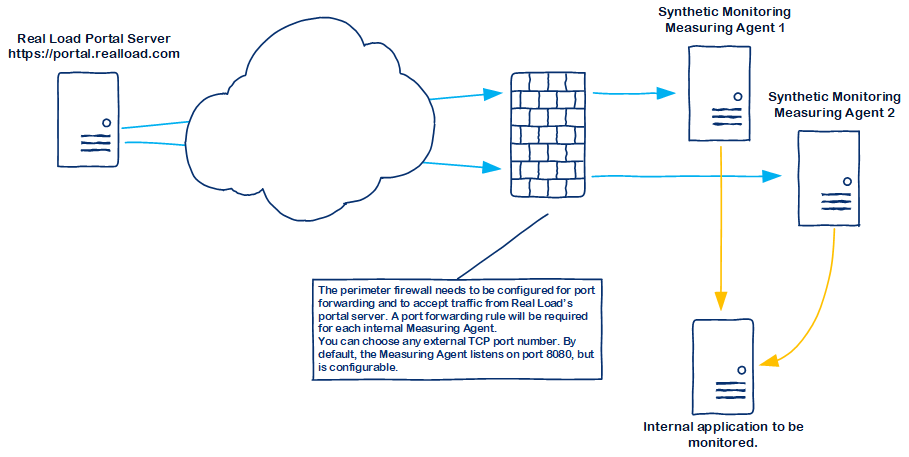Deployment Types & Architecture
First of all you’ll have to decide which RealLoad deployment type better suits your needs. These guidelines should assist you in making an informed decision.
Architecture
There a few components that make up the RealLoad solution. Most components are available under an SaaS model which doesn’t require any infrastructure commitment from your side.
If required by security or other constraints, some or all components can be deployed on your own infrastructure. Please reach out to us to discuss requirements if you’re planning to go down this road.
The key components that make up RealLoad’s solution are:
The Portal Server
- Exposes the main GUI to end users.
- All tasks to maintain Load Testing or Synthetic Monitoring scripts are performed here.
- Load Tests are can be triggered via the Portal.
- The Synthetic Monitoring dashboard is visible here and shows the current state of configured tests.
Measuring Agent
- Load Test and Synthetic Monitoring scripts are executed from Measuring Agents.
- For Synthetic Monitoring purposes, you can use shared or dedicated agents to execute your tests from.
- The Measuring Agent needs to be reachable from RealLoad’s portal server and needs to be able to reach the servers to be load tested or monitored.
- You can have multiple Measuring Agents, for example to execute Synthetic Monitoring tests from different locations.
There are 2 options for your to run AWS cloud based Measuring Agents:
- Using our Cloud Credits: The relevant Virtual Machines are spun up from our portal under our own AWS account and you pay a usage fee using Cloud Credits you’ve previously purchased from us.
- By starting pre-configured AWS AMIs under your own AWS account. You’ll be charged directly for AWS related costs.
Cluster Controller (Optional)
- If your Load Testing requirements exceed the load generating capacity of a single Measuring Agent, you can combine multiple agents in a cluster using a Cluster Controller.
- Like measuring agents, Cluster Controllers can be hosted in the cloud or on your own infrastructure, as per your requirements.
Proxy Recorder (Optional)
- You can use the Proxy Recorder component in order to develop test scripts by recording HTTP traffic while it transits through it.
- The Proxy Recorder can be run in the cloud, as a service on your own infrastructure or directly on your Desktop using the Desktop Companion.
Typical deployment scenarios
Load Testing using Cloud Credits
The RealLoad portal gives you the ability to launch load generators (Measuring Agents) in the AWS cloud with a click of button and the execute a load test.
Key features and requirements are:
- You’re not required to have an AWS account, as the Measuring Agent is run under RealLoad’s AWS account.
- You pay for the AWS and RealLoad licensing costs using previously purchased Cloud Credits.
- The application to be load tested needs to be reachable from the Measuring Agent’s public IP address, assigned by AWS at launch.
- Cloud Credits can be purchased in the RealLoad shop, at this link: https://shop.realload.com/cloud-credits-2
- The cost charged by RealLoad to run Measuring Agents using Cloud Credits varies by AWS EC2 instance type. See this table for details: https://shop.realload.com/cloud-credits

Load Testing by running the Measuring Agent behind perimeter firewall
Using Cloud Credits is not an option if the servers to be performance tested are not exposed to the internet. In this scenario, the Measuring Agent will need to be deployed behind perimeter firewalls as follows:
- In AWS: You can launch our pre-configured AMIs under your AWS account and attach them to your VPCs.
- If preferred, Measuring Agent instances can be launched using our convenient Desktop Companion application.
- If running on non-AWS infrastructure: Install the Measuring Agent on a supported Linux Distribution.
Key features and requirements are:
- The Measuring Agent needs to be reachable from the internet based Portal Server. You’ll need to configure firewall and NAT rules on your perimeter firewall to allow communication.
- You’ll need to update the Measuring Agent software from time to time, to stay compatible with updates on the Portal Server.
- You’ll need to purchase a Load Testing license to suit your load requirements.
- See our online shop for pricing of commonly used license sizes. Reach out to us if you have different licensing requirements. https://shop.realload.com/load-test-licenses

Synthetic Monitoring of Internet exposed services
Typically Synthetic monitoring is use to monitor services that are exposed to the internet. RealLoad uses Measuring Agents to implement the monitoring functionality.
We recommend executing Synthetic Monitoring tests from at least 2 Measuring Agents, to cater for transitory local disruptions (like network issues or agent software updates) which might trigger false positive alerts.
There are two types of agents you can use for monitoring purposes:
- Shared Agents: These are Monitoring Agents shared by multiple customers. Using these agents is included in the basic cost of the monitoring service.
- Dedicated Agents: If you need to execute monitoring from a specific location or you don’t want to use a shared agent, we can setup a dedicated agent for you. This will incur additional costs, plz reach out to us to discuss.
Key features and requirements are:
- The application or service to be monitored needs to be reachable from the internet.
- You’ll need to subscribe to a Synthetic Monitoring plan. Reach out to us for pricing.

Synthetic Monitoring of services running behind perimeters firewalls
Should you have the need to monitor services within your perimeter, this can be arranged by deploying Measuring Agents within your networks.
Key features and requirements are:
- You’ll need to deploy two measuring agents behind the firewall perimeter. For AWS deployments your can use our existing AMIs, for other infrastructure install the Measuring Agent on a supported Linux Distribution.
- You’ll need to update the Measuring Agent software from time to time, to stay compatible with updates on the Portal Server.
- The Measuring Agents need to be reachable from the internet based Portal Server. You’ll need to configure firewall and NAT rules on your perimeter firewall to allow communication.
- You’ll need to subscribe to a Synthetic Monitoring plan. Reach out to us for pricing.
